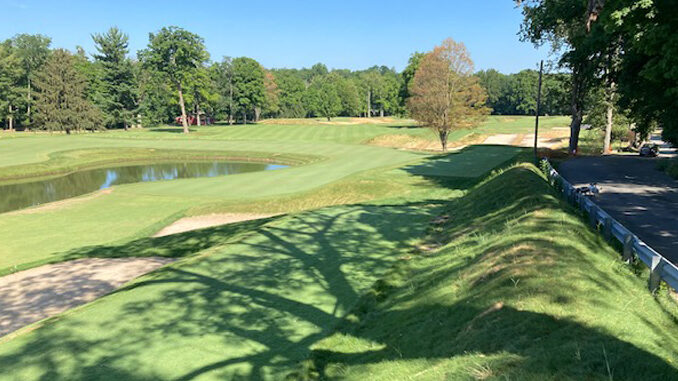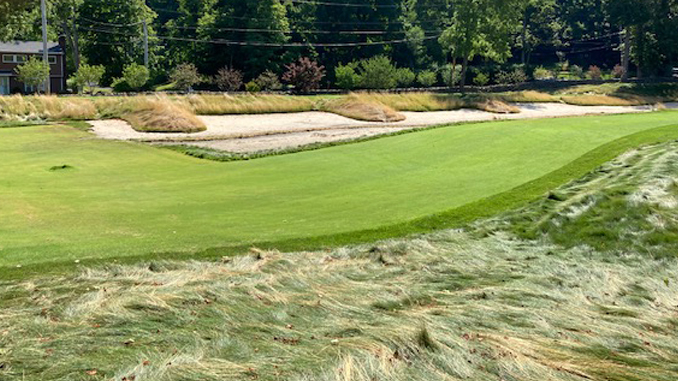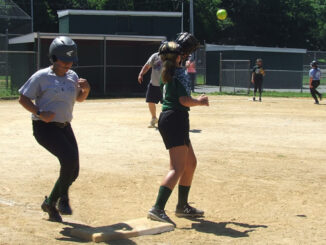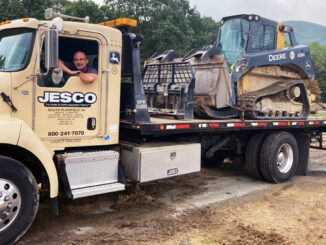
Storm King Golf Club expected to open next summer
By DAVID NOLAND
(This is the last installment of a three-part series. Parts One and Two covered the history and bankruptcy of the Storm King Golf Club, the subsequent sales of the property, and the Town’s approval process for the current course renovation. Part Three now focuses on the current course renovation, and whether — and if so, how — local golfers and sledders will have access to the course.)
The current schedule calls for the cadet practice area — the lower third of the course, nearest Main Street — to open this September. The rest of the course should be ready for “preview playing days” next summer, with the official grand opening of the entire course now set for September 2023.
Will the final result be worth all the toil and trouble? New owner Trey Owen has very big plans for the property. A 36-page document entitled “Storm King Golf Club Transformation Project,” describes an entirely new kind of golf course: a dense patchwork of 16 tee boxes and 11 greens, all fitting into the area of the previous 9-hole course. Some of the massive convoluted putting surfaces will share two, three, or even four flagsticks for separate holes. The tees and greens can be played in a variety of combinations to make up more than 50 distinct holes.
“A one-of-a-kind, exceptional, and a highly memorable but ever-changing golf experience,” intones the document. Chris Gray, the golf course architect who designed the complex layout, calls it “beautiful chaos.”
Reassuringly for traditionalists, there is a standard 18-hole course embedded in the chaos. Golfers will be also able to play a variety of 9-hole loops that start and end at the clubhouse, plus a virtually infinite number of loops of 3, 6, 9, 12, or 15 holes that start and finish at various locations across the property. Want to play seven consecutive par-5 holes? No problem. Nine consecutive par-3s? Step right up.
“It’s a unique golf experience that just doesn’t exist anywhere else in the world,” says Gray, with undisguised pride.
But who exactly gets to savor this “unique golf experience?”
Back in the beginning, Owen pledged to then-Supervisor Randazzo that he would allow course access to local golfers,
According to the promotional document, the course will be open to players “in good standing with the Hudson Valley Golf Foundation”. And just how does one achieve this good standing?
“We don’t know all the variables yet,” admits Owen. For now, he envisions “members” who will be known as Ambassadors or Patrons. They’ll have to make an initial tax-deductible donation to the Foundation, and annual donations thereafter to maintain supporter status.
The proposal document mentions a mysterious “SKGC Society,” whose members must be “true friends of West Point,” and “somewhere from invisible to mysterious for those outside it.” They must also be “old-school humble.”
The level of donation required to become one of these humble, mysterious Patrons has not yet been determined. “A lot depends on how our fund-raising goes,” says Owen. “The more straight-up donations we get, the less play-related revenue we’ll need.”
How this “play-related revenue” fits the requirements of 501(c)3 tax-exempt organizations remains to be seen. Already the Foundation has applied for a property-tax exemption. The request was initially denied by the Town Assessor, on the grounds that the property was not yet being used for any exempt purposes. (At this point, after all, the Foundation is basically an earth-moving organization.) But the Foundation appealed the ruling, and the Town’s Board of Assessment and Review recently overruled the Assessor and granted the property tax exemption.
The Foundation’s properties are currently assessed at $806,400. Last year’s tax bill was around $30,000. Very roughly, that’s the cost of a couple of days’ construction work on the course.
And what might the assessed value be after $8 million worth of renovation? An interesting question that is now moot.
Property tax issues aside, what about the basic logistics of playing the course? How will those humble, mysterious Patrons navigate the chaos of possible course routings to avoid bombarding other golfers (and being themselves bombarded) with flying golf balls? Even the “standard” 18-hole course embedded in the chaos will have criss-crossing holes that will be potential shooting galleries.
“We’re not sure yet how we’re going to work that out,” says Owen. “We’ll be learning on the fly. But it will be much more limited play, maybe only two or three groups on the course at a time. It’s got to be safe.”
On a recent June morning, Gray gave me a tour of the site. At the construction base where Hasbrouck Avenue cuts across the old first fairway, we hopped into a four-wheeler and bucked through the mud down the old sledding hill, now resculpted and unrecognizable, past snorting back-hoes and huge piles of dirt, till we reached the 20-odd acres at the northwest end of the course that have been essentially completed.

Reverting to foot travel, we strolled past a new wind-riffled lake, along rolling fairways ,and across massive, velvety multi-lobed greens. (The greens are huge almost beyond belief, totaling more than 200,000 square feet—ten times the greens area of the old course. )
There was a smattering of big mature trees, but the landscape had been so transformed that I couldn’t even remember where the now-removed trees had been. And to my delight, there were no paved cart paths to spoil the rolling expanse of green. Gray told me that it would be a walking-only course, except for a few special low-footprint carts for disabled veterans.
Although, like many Cornwallites, I’d been horrified by the initial construction blight, I had to admit that the scene before me now was stunningly beautiful, in a man-made sort of way. I have little doubt the rest of the course will eventually hit that mark as well.
And good news for sledders and skiers: Town Supervisor Josh Wojehowski has negotiated an agreement with Owen to open up the hill below the clubhouse when it snows, with parking allowed in the clubhouse lot. But asked about off-season access for dog-walkers and strollers, Gray replied, “If there’s no snow, we’ll have to talk about that.”
Likewise, there is still much to talk about on the details of course access for local golfers. The most likely scenario: If you make an as-yet-unspecified “donation,” you’ll occasionally — when the cadets aren’t practicing, and there’s no charitable event — be permitted a round of golf unlike any you’ve ever played: no golf cart, maybe 18 holes, maybe not, over a meandering unpredictable route, hardly anybody else on the course, and with the possibility of a 200-foot putt. And, by the way, no 19th hole; the restaurant and bar will be reserved for Foundation events only.
For traditionalists, this may not qualify as actual “golf,” but rather a “golf-related experience.” Still, sounds like it could be fun. We’ll see.



